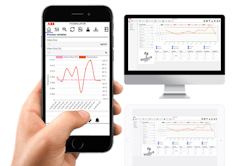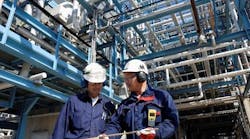It is hard to believe that it was 45+ years ago that the groundwork for Ethernet was laid down at Xerox PARC, with a patent following in 1976. Considering its age, it has proven its longevity and capabilities and has performed admirably in its role as the de facto standard for contemporary IT and OT operations globally.
Following multiple evolutions that have improved and upgraded its performance – and its adoption as an IEEE standard in 1989 – it is hard to envisage any form of data-rich connected operation that could not exploit the capabilities of this robust and proven protocol.
With an eye on recent developments, far from tempering its uptake, the advent of Industry 4.0 and the Internet of Things (IoT) have reinforced its proliferation, as seamless device-to-enterprise connectivity becomes the must-have capability for everything and everyone. Indeed, putting pertinent, timely data in the hands of people (or AI) who can then make instantaneous operationally beneficial decisions, is the foundation of modern industrial practices.
With its near real-time communication capabilities – for both control and safety – transmission speeds in excess of 1 Gbit/s and the all-important determinism, standard Ethernet covers the bases, and those that it doesn’t – normally through no “fault” of the protocol – are covered by alternative variants, such as fiber optics, which can offer data transmission across huge ranges, a well-documented limitation of copper.
Over the last 20 years, it has faced some challengers, especially in the fieldbus wars of the late 1990s early 2000s, but with IT/OT convergence driving the digital transformation paradigm, nothing was going to usurp it in the office space and, with its industrial capabilities well proven, world domination was only a matter of time.
The fieldbus protocol war may have been won at most automation levels, but there are still pockets of resistance at lower levels as other, equally long-standing communication and connectivity architectures maintain a foothold in certain applications, using the argument “if it ain’t broke, don’t fix it.”
These protocols certainly are not broken, per se, and they still perform admirably when presented with their original mission, but the landscape in which they reside has changed. The narrative is demanding far more information, and most applications need two-way information capabilities far beyond their original intended purpose.
A case in point would be a stalwart of a huge array of device-level applications – the 4-20 mA current loop. The reason for this protocol’s dogged resistance is not really due to what it can offer — it is more a case of what Ethernet could not offer field instrumentation, which is deployment in hazardous areas (Ethernet in its current standard guise is not intrinsically safe) and two-wire connectivity (traditional Ethernet requires four).
Although there are obvious architecture pressures, there are markets where not being intrinsically safe is not a deal breaker, such as the water/wastewater industry, and the data capabilities of a four-wire system are a far more attractive prospect, especially in the face of Industry 4.0 frameworks.
Compounding these arguments in support of 4-20 mA is the requirement for power, which adds an extra level of complexity to networks. But, like its previous iterations, Ethernet has evolved to address this requirement with the advent of Power over Ethernet (PoE).
In one fell swoop, the complexity argument becomes a moot point, as Ethernet architectures can now deliver all the capabilities required to unlock the data-generation potential of even the most commodity-product-based smart architecture.
4-20 mA was great at delivering one value, but if we look at our previously mentioned water industry example, the latest PoE-enabled flowmeters are capable of delivering far more than just one value; they can tell you density, volume flow or mass, but to unlock this data, you need a more capable network, which is where PoE sets out its stall.
4-20 mA does not tell you any device details either, and the information you do get is hard to turn into anything meaningful. What exactly does this 18 mA signal mean? The problem is that people have just come to accept that any additional data is locked away. You can still use the incumbent protocols and equipment, but they will not benefit from any innovation … and any innovation will not benefit from them.
Digital data signal processing has been around for 20 years; we are connecting things that were isolated before and generating so much data that can be leveraged for wider improvements. But in order to optimize operations, you need to connect to lots of different data sources, all delivering multiple data sets, and Ethernet is the new common language.
From a purely electrical perspective, there are two sides. The electrical signals in PoE fall outside the requirements for professional/qualified installers, so the argument against using Ethernet – especially when everything is available in a single cable – fall by the wayside. However, the safety aspect must be considered.
Ethernet already underpins some very tough communication roles for security and safety measures, but in the chemical industry, for example, you have to consider explosive atmospheres too. Ethernet in a standard guise cannot run in these applications, as there are no limitations to current/voltage, so you cannot guarantee against sparks between two wires.
As you probably expected, Ethernet has these “limitations” in its sights too. A new Ethernet standard – Ethernet-APL (advanced physical layer) – will not only deliver communication and power with just two wires over long cable lengths but will also do so while offering explosion protection via intrinsic safety. As it is based on existing IEEE and IEC standards, Ethernet-APL will seamlessly support existing Ethernet-based automation protocols and is anticipated to underpin future developments in the highly competitive and demanding process automation space; indeed, elements of the ABB product roadmap have APL as a core foundation.
From a functional perspective, as well as delivering larger data sets, it is possible to exploit on-board web servers too, giving operators an HMI-style view of a flowmeter. These can then be configured far more easily and without potentially expensive software licenses.
The possibilities delivered by PoE-based products are vast, and Ethernet-APL will simply expand on this. The long-term view looks incredibly exciting. Conversion over to a new architecture is not going to be straightforward, but the payback versus the engineering effort will be incredibly quick.
There is already massive demand from the water industry for PoE, especially in the USA, and commensurate interest from the chemical and oil and gas industries for Ethernet-APL. Indeed, the chemical industry, under the auspices of Namur, is already developing concepts for pure Ethernet-based automation architectures, what they would look like and how they would function. Representatives at ABB are already getting questions regarding product availability.
It really is hard to underestimate the new-found capabilities these protocols will offer, but they will help to unlock data that was previously hidden, allowing industries to rewrite the rule books on operational insights and efficiencies.
Tilo Merlin is a platform manager at ABB, a technology leader that is driving the digital transformation of industries.



